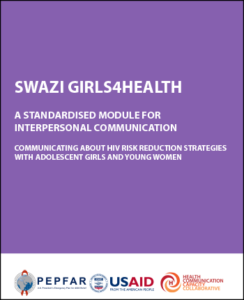Swazi Girls4Health: Communicating About HIV Risk Reduction Strategies with Adolescent Girls and Young Women
The goal of Swaziland’s extended National Multisectoral Strategic Framework for HIV and AIDS (eNSF, 2014–2018) is to halt the spread of HIV and reverse its impact on Swazi society. The first priority, in pursuit of that goal, is to prevent new HIV infections and reduce mortality among people living with HIV (PLHIV).
Political and community leaders in Swaziland, in concert with service providers and the support of development partners, are working tirelessly to combat the HIV epidemic. But more work needs to be done to reach the right people in the right places with the right messages and services that address their unique vulnerabilities to HIV and AIDS. One of the strategic gaps among HIV prevention programming identified in the eNSF is inadequate targeting of interventions and services and a lack of intensity for reaching those most vulnerable.
This guide was developed to address this gap by focusing on the age group of adolescent girls and young women (AGYW) that face the highest risk of HIV acquisition and/or transmission, and defining a communication package that addresses key behavioural determinants that influence desired behavioural outcomes in respect to uptake of key HIV prevention services. The basis for the guide is the eNSF and the Core Package for HIV Prevention: Guidelines for Implementers. The design was modelled after the Tasankha Discussion Guide, produced by the Malawi BRIDGE II project, also implemented by CCP.


Leave a Reply
Want to join the discussion?Feel free to contribute!